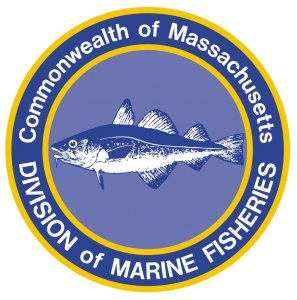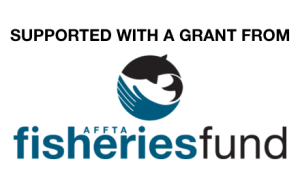The Striped Bass Fishery In Our Hands
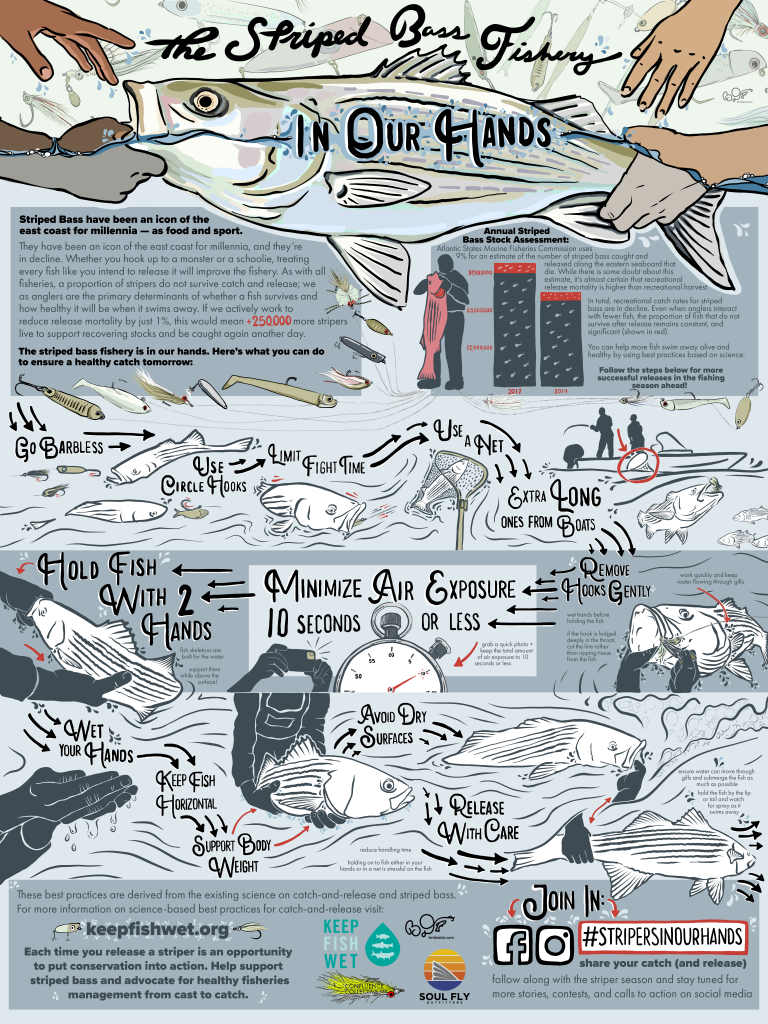
Our friends and conservation partner Keep Fish Wet have teamed up with Confluence Collective, Soul Fly Outfitters and Maine based artist and angler Bri Dostie to develop a grassroots campaign to help address recreational catch and release mortality.
The Striped Bass fishery is one of the most popular recreational fisheries in the United States. The most recent ASMFC stock assessment released in 2019 showed that over 41 million fish were caught in the recreational fishery. And as striped bass anglers travel, fish, and shop along the east coast, they inject millions of dollars into local economies.
Currently, Striped Bass populations are at a 25 year low according to the Atlantic States Marine Fisheries Commission. While commercial harvest has decreased somewhat and the recreational harvest has been declining steadily since 2015, it’s estimated that the largest portion of mortality in the fishery comes from fish that are caught and released but do not survive. This is where recreational anglers have the ability to play a significant role and create positive change.
Scientist quote: “Just saying practice catch-and-release isn’t good enough, since not all fish that are released survive,” said Dr. Andy Danylchuk, Professor of Fish Conservation at UMass Amherst, and Science Advisor for Keep Fish Wet. “Fortunately, there is a growing body of science showing anglers can making subtle changes in their behavior and how they catch and handle fish that can reduce release mortality and make a meaningful impact of the fishery we all care about”
“If you choose to release a fish and you would like that fish to live and remain healthy, there are some simple science-based steps you can take,” says Sascha Clark Danylchuk, the Executive Director of Keep Fish Wet. The three most important things you can do are to:
- Minimize air exposure
- Avoid dry surfaces
- Release with care
“Scientists know a lot about how human interactions affect the fish we catch, but that information doesn’t help anyone if it stays in a journal article behind a paywall,” said Dostie. “We wanted to make sure every angler is empowered with the information they need to protect the fish they care about — and art is one way to share that information more broadly.”
The Striped Bass fishery is in our hands. We as anglers have the opportunity to improve survival rates by taking care of every fish we encounter. Take these science-informed best practices for handling fish into consideration next time your on the water:
- Consider going barbless for smooth hook-ups and clean hook removals. If you’re using live bait, use circle hooks.
- Limit fight time: every second on our line adds stress and takes energy from the fish, leaving them with less for recovery.
- Use a net: this can bring fish in fast and is especially helpful when fishing from a boat. Rubberized nets are best, as they do less damage to fins and slime. By using a net we can also keep the fish submerged while removing the hook safely.
- Remove hooks gently: if needed use a tool and cut the line if deeply hooked.
- Minimize air exposure and Avoid Dry Surfaces: 10 seconds out of the water in total, just enough time to remove that hook, snap a quick photo, and prepare for release.
- Hold fish with 2 wet hands to support their weight out of the water, keeping the fish secure while not removing too much protective slime.
- Holding fish horizontally helps avoid damage to the skeletal and organ systems.
- Release with care! Holding a fish by their lip or tail is best, making gripping tools irrelevant. Only revive fish that cannot swim on their own.
The state of the fishery is truly in our hands, even a small improvement in catch and release mortality would have a huge impact in the overall health of the stock. For more information please check out the Stripers In Our Hands page on the Keep Fish Wet website.
ACTION ALERT- MADMF ADDING COMMERCIAL FISHING DAYS
ACTION ALERT
Oppose Plans to Increase Commercial Fishing Pressure on Striped Bass
Once again, the Massachusetts Division of Marine Fisheries (DMF) has proposed changes to the commercial striped bass fishing regulations for 2021, specifically intended to increase the harvest of breeder-sized Striped Bass.
If adopted, the changes will open the season earlier, add more days to the fishing week, and automatically add additional days—up to seven—if the quota is not on pace to be filled. Their justification is that economic hardships due to COVID-19 compel DMF to open the regulations to aid commercial fishermen.
Stripers Forever believes this policy is reckless and in direct opposition to the ASMFC’s current efforts to amend its policies to protect and restore Striped Bass to abundance. The ASMFC has declared striped bass “overfished, and overfishing is occurring,” and yet DMF wants to increase commercial fishing pressure.
The state is currently taking written public comments on this policy and will hold a virtual public hearing (link to register below) on Monday, March 29 at 6pm. We urge all members of Stripers Forever to write in opposition to this proposal and to register to attend the hearing and voice your opposition as well. Here is a link to the notice of public hearing for the draft regulation amendment.
PLEASE ACT NOW! SUBMIT YOUR COMMENTS TO THE MADMF:
The DMF is accepting written public comment on these proposals through Friday April 2, 2021.
ADDRESS ALL COMMENTS TO: Director Dan McKiernan
EMAIL: marine.fish@mass.gov
POST MAIL: 251 Causeway Street, Suite 400, Boston, MA 02114
REGISTRATION LINK FOR THE VIRTUAL PUBLIC HEARING (Monday, March 29 at 6pm): https://us02web.zoom.us/webinar/register/WN_GlH6svHUSr6CzQoc21ZkdA
MADMF NOTICE PDF: https://www.mass.gov/doc/030521-public-hearing-on-commercial-fishery-rules-affecting-striped-bass-menhaden-black-sea-0/download
ACTION ALERT- ASMFC Draft Amendment 7 PID (Public Information Document)
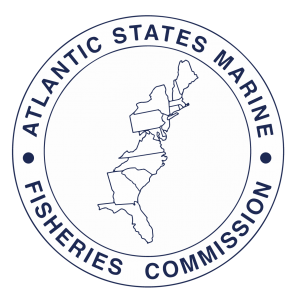
ACTION ALERT
ASMFC Draft Amendment 7 PID (Public Information Document)
The Atlantic States Marine Fisheries Commission (ASMFC) has produced a Public Information Document (PID) requesting comments and input from interested parties regarding the Striped Bass fishery. “This is your opportunity to inform the Commission about changes observed in the fishery, actions you feel should or should not be taken in terms of management, regulation, enforcement, and research, and any other concerns you have about the resource or the fishery, as well as the reasons for your concerns.” -ASMFC
The full PID can be found here: Draft Amendment 7 Public Information Document (PID) Public Comment Feb. 2021
The audio/video Public Hearing Presentation can be found here: https://www.youtube.com/watch?v=DdHHIifU7DI&feature=youtu.be
Registration for live hearings (all states) can be found here: https://register.gotowebinar.com/rt/8168283291056270608
Stripers Forever has studied the PID and have formulated responses to each of their areas of concern. Our comments are numbered 1 through 10, corresponding to the numbered document. What follows is a summary of our official positions on each area.
IMPORTANT NOTE: When reading these SF position statements, please compare them to your own thoughts and then, in your email to the ASMFC, formulate your own comments IN YOUR OWN WORDS. We strongly suspect that all comments received by the ASMFC that use the same language/wording get lumped together and end up counting as only one point of view from one source. Make your comments your own in order to make them count. They can be as brief or lengthy as you wish.
The items included in the PID are: 1. Fishery Goals and Objectives 2. Biological Reference Points 3. Management Triggers 4. Stock Rebuilding Targets and Schedule 5. Regional Management 6. Management Program Equivalency (Conservation Equivalency) 7. Recreational Release Mortality 8. Recreational Accountability 9. Coastal Commercial Allocation 10. Any other issues concerning the management of Atlantic striped bass.
Note that the current management regime under Amendment 6 was adopted in 2003, and failed in its objective to rebuild stocks.
Please refer to the PID for specific language on each of the following issues.
Issue 1: Goal (“To perpetuate… migratory stocks of striped bass.”) is fine.
- Objective 4 (“Foster quality and economically viable recreational, for-hire, and commercial fisheries.”): remove the commercial reference. Recreational anglers are the overwhelmingly dominant user both in terms of numbers of participants and economic impact. Managing for commercial interests runs counter to the greater public good.
- Objective 6 (“Adopt a long-term management regime that minimizes or eliminates the need to make annual changes or modifications to management measures.”): Gamefish status would solve this.
Issue 2: SF’s position is to maintain existing biological reference points (BRPs) since we know that the stock can attain those levels as it has in the past.
Issues 3 & 4: Management triggers & timeline (“Up to ten years.”): Keep what is there and follow what they say should happen. Triggers were ignored after implementation in Amendment 6 and that is at least part of why the stocks are where they are today after 18 years of a ten-year plan. For Issue 4, SF’s position is to rebuild the stocks, and maintain, sustain abundance, vs. manage for “maximum sustainable yield.”
Issue 5: Regional Management is a good idea. Chesapeake Bay is the Striped Bass’ primary nursery and should be managed differently than the coastal fishery should be different. In addition we are strongly recommending the adoption of seasonal closures in spawning locations such as the Hudson River. Striped Bass should be given the opportunity to spawn without human intervention. Closing the Hudson River, Ny Bight and Raritan Bay to Striped Bass Fishing in the spring would protect large females as they migrate from spawning grounds into their coastwide distribution. This is a no brainer and we believe it will dramatically protect and improve the spawning stock biomass. It won’t be easy though, unless you have game fish status.
Issue 6: Conservation Equivalency should be status quo, but with consequences when states adopt CE measures that fail to achieve desired outcomes.
Issue 7: Recreational Release Mortality: The circle hook requirement is fine as implemented in Addendum VI. Treble hook use on artificial lures, and proper handling should be a continuing education process.
Issue 8: Recreational Accountability: Implementing recreational harvest limits (RHLs) will be a problem until the Marine Recreational Information Program (MRIP) is supplying timely and high confidence data.
Issue 9: Coastal Commercial Quota Allocation; The simplest answer is to make it a game fish. End of story. Harvesting juvenile fish in Chesapeake Bay and larger, breeder-size females along the coast runs counter to achieving management goals.
Issue 10: Other issues: “How would you like management of the Atlantic striped bass fishery to look in the future?” Stripers Forever stands by its mission: Make it a Game Fish.
Stripers Forever remains committed to fighting for Striped Bass designation as a game fish, protected from commercial harvest. That is beyond the ASMFC’s charter, and so the following recommendations reflect what we believe to be steps that are both reasonable and aggressive, carving the surest path to rebuilding healthy, abundant Striped Bass stocks, based on the goals of the ASMFC as stated in the PID for adoption of Amendment 7.
- Moratorium (coast and bay, no recreational or commercial harvest) of 10 years’ duration to ensure the success of the ASMFC’s 10-year stock rebuilding plan.
- No targeting Striped Bass in traditional spawning areas, as determined by local authorities.
- Issue a $25 Striped Bass stamp to fund and support collection of timely, high-confidence MRIP data.
- Ban the commercial gillnet fishery (Coast and Bay); adopt hook-and-line fishing only where commercial harvest persists.
- Include a metric to account for commercial release discard mortality (including bycatch and poaching) to ensure accurate commercial impact and accountability.
- Stronger punishments for poaching (counting black market catch against commercial quota, lifetime ban from all commercial and recreational fisheries for multiple or egregious offenders, gear forfeiture, larger fines, etc.).
- Limit treble hooks to one per artificial lure.
- Require barbs on artificial lures be flattened when used for striped bass.
You have an opportunity to influence the overall management of our Striped Bass right now. We all need to join forces and submit comments to the ASMFC that state loudly and clearly that the health of the Atlantic Striped Bass stock – not harvest – should be the highest priority of Amendment 7. Stripers Forever has a singular mission to put the fish first – let’s all do our part to communicate this same message to the ASMFC and to your state’s ASMFC reps to the Atlantic Striped Bass Management Plan.
For full information and a schedule of state-by-state public hearings on the Atlantic Striped Bass Draft Amendment 7 PID in March – please see the ASMFC’s NEWS RELEASE.
Registration for live hearings below can be found here: https://register.gotowebinar.com/rt/8168283291056270608
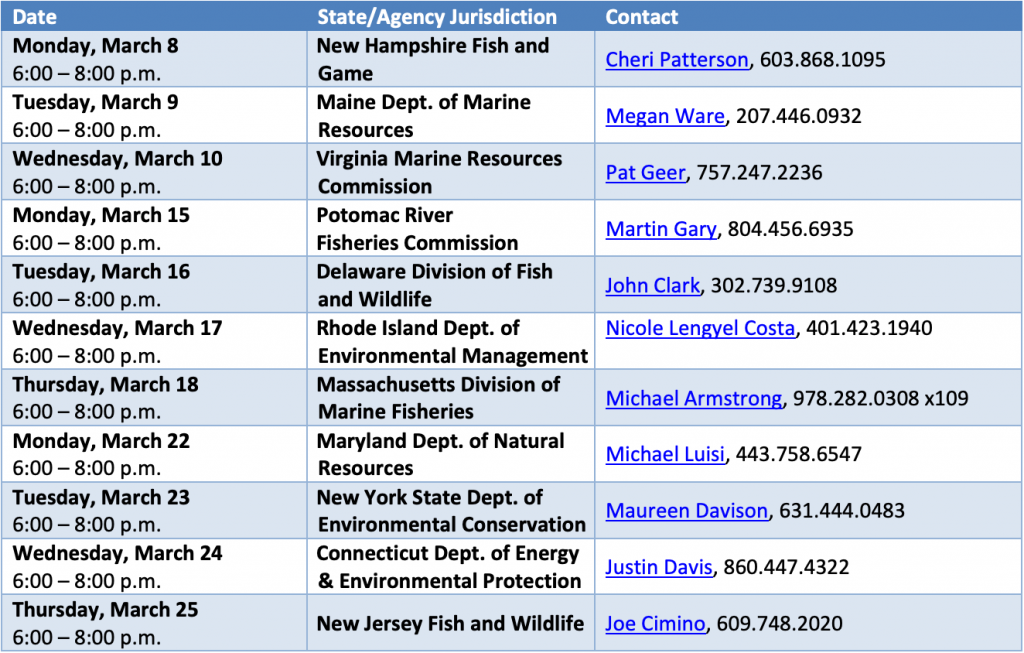

Public comments are being accepted through 5pm, April 9, 2021 and can be emailed to comments@asmfc.org (Subject line: Striped Bass PID). Also consider sending comments directly to your state’s commissioners to the Atlantic Striped Bass Management Plan.
Please also copy your state’s delegation on any comments to the ASMFC. Here is link to state board and advisory commission members.
Thank you!
ADDITIONAL LINKS
- Atlantic Striped Bass Board- February 3, 2021 Meeting Audio/Video (YouTube)
- Atlantic Striped Bass Board- February 3, 2021 Meeting (Collected Slides PDF- No Audio)
- Atlantic Striped Bass Board- Main Meeting Materials
- Atlantic Striped Bass Board- Supplemental Meeting Materials 1
- Atlantic Striped Bass Board- Supplemental Meeting Materials 2
- Atlantic Striped Bass Board- PID Public Comment News Release
- Atlantic Striped Bass Board- Draft Amendment 7 Public Information Document (PID) Public Comment Feb. 2021
ASMFC 2021 WINTER MEETING SUMMARY & ACTION



ATLANTIC STRIPED BASS MANAGEMENT BOARD MEETING SUMMARY
The ASMFC’s winter meeting took place last week and the Atlantic Striped Bass Management Board convened and there are some important takeaways for those of us interested in the health of the fishery. Below you will find a summary of the results of the meeting and, based on these developments, some suggestions for how we can keep fighting to influence better policy.
At the bottom of this summary you will find links to the meeting documents as well as the YouTube link to view the meeting recording. If you missed the meeting we encourage you to take a look.
Recreational Release Mortality Still a Matter of Debate
The meeting opened with a presentation of stock assessments based on alternative recreational release mortality data. In short, when best-case and worst-case scenario data were used to calculate the effect on Striped Bass, the results were just about the same as they are believed to be today—which is not good. But the presentation revealed several important deficiencies: fisheries managers regard a fish released properly the same as one subject to the abuse common to those caught and released from a party boat (angler behavior), high-temperature/low-oxygen conditions and size/age of the fish. It’s unclear how usable or valuable this data is without taking those criteria into consideration. There’s nothing much we can do about it except collectively practice good catch-and-release techniques.
Stock Assessment Delayed
The technical committee voted to delay updating the Striped Bass stock assessment that had been scheduled for this year. Because of the new regulations and effects of the pandemic, the assessment was delayed until 2022 with the hope that the data will be better. There is also a “two stock” model for evaluating both ocean and Chesapeake Bay stock health that may be used in the 2022 assessment if it passes peer review.
Circle Hook Exemption Debated
There was a lengthy debate over a proposal by Massachusetts and Maine to exempt “tube and worm” rigs from the circle hook mandate for bait fishing. The two states want two years to study whether tube and worm rigs, which are popular with the for-hire fishery, result in deep-hooking of fish. Most agreed that, because tube & worm rigs are fished actively—trolled or retrieved—the danger of deep hooking was minimal, but some expressed concerns that the exemption would be used as a loophole.
This debate took almost 2 1/2 hours and led to almost 100 public attendees leaving the meeting, likely out of pure frustration. Much like conservation equivalency, as soon as 1 or 2 states asked for the exemption the rest followed suit. No doubt this was a massive waste of time for both the board and the public. This study could have been conducted in 1 state as the results could be applied to the entire fishery, there is no need to make this into a coastwide ‘study’.
Ultimately the exemption passed and now we are faced with the possibility of loophole, compliance and enforcement issues. Not to mention making already complex regulations more confusing to the public. We will continue to follow this issue and update when necessary.
Public Input Encouraged for Upcoming Management Changes
The most consequential item discussed during the meeting concerned adoption of a “public information document” (PID) to be issued in advance of work on Amendment 7 to the Striped Bass management plan. A PID is issued to help inform the public prior to the solicitation of input for the drafting of a new management plan. That PID has since been issued (link below), and soon the ASMFC will schedule public hearings and ask for suggestions that will help shape the future of striped bass fisheries management along the Atlantic coast.
Stripers Forever is reviewing the PID and will make recommendations for how we can be an important part of that discussion and make sure the recreational fishing community is heard on this matter. It will be vital that we speak in one clear voice when the time comes. We welcome your input and ideas during this time, please email us at stripers@stripersforever.org.
It was clear during the meeting that there are still those intent on putting pressure on the Commission to increase the commercial harvest, arguing that the stocks are fine and recent cuts are due to miscalculations. John Clark, fishery manager from Delaware, claimed that there were so many striped bass in Delaware Bay they were emaciated because of a lack of forage. Because people like John are relentless in their efforts, we all must be as well.
Speak Loudly and Be Heard
We know that conservation-minded, recreational anglers constitute an overwhelming majority of the striped bass fishing public. We know we can be a powerful voice for protecting these valuable fish for the future. We will do what we can to have our collective voice of conservation heard and heeded.
Stay tuned. We will keep you all informed through email, social media, and our website. Thanks for your participation in the conservation of Striped Bass…Make it a Game Fish!
LINKS
- Atlantic Striped Bass Board- February 3, 2021 Meeting Audio/Video (YouTube)
- Atlantic Striped Bass Board- February 3, 2021 Meeting (Collected Slides PDF- No Audio)
- Atlantic Striped Bass Board- Main Meeting Materials
- Atlantic Striped Bass Board- Supplemental Meeting Materials 1
- Atlantic Striped Bass Board- Supplemental Meeting Materials 2
- Atlantic Striped Bass Board- PID Public Comment News Release
- Atlantic Striped Bass Board- Draft Amendment 7 Public Information Document (PID) Public Comment Feb. 021
